Submitted:
29 February 2024
Posted:
01 March 2024
You are already at the latest version
Abstract
Keywords:
1. Introduction
2. Materials and Methods
2.1. Experimental Field
2.2. Online Soil Scanning and Sampling
2.3. Laboratory Scanning and Analysis
2.4. Online vis-NIR Spectral Prediction Models and Maps
2.5. NDVI Data Collection
2.6. Management Zones Delineation and Application Map
2.7. Crop Management and Yield Measurement
2.8. Cost-Benefit and Environmental Analysis
2.9. Statistical Analysis
3. Results
3.1. Accuracy of Prediction Models of Online vis-NIR Sensor
3.2. Spatial Variation in Soil Fertility
3.3. Crop Yield Response to Variable Nitrogen Application
3.4. Cost-Benefit and Environmental Assessment of Variable Rate Nitrogen
4. Discussion
4.1. Models Accuracy
4.2. Within Field Spatial Variability
4.3. Variable Rate Nitrogen Impact on Crop Yield
4.4. Cost-Benefit and Environmental Analysis
5. Conclusions
Author Contributions
Funding
Data Availability Statement
Acknowledgments
Conflicts of Interest
References
- Zhang, X.; Davidson, E.A.; Mauzerall, D.L.; Searchinger, T.D.; Dumas, P.; Shen, Y. Managing Nitrogen for Sustainable Development. Nature 2015, 528, 51–59. [CrossRef]
- Schulte-Uebbing, L.F.; Beusen, A.H.W.; Bouwman, A.F.; De Vries, W. From Planetary to Regional Boundaries for Agricultural Nitrogen Pollution. Nature 2022, 610, 507–512. [CrossRef] [PubMed]
- Guerrero, A.; De Neve, S.; Mouazen, A.M. Data Fusion Approach for Map-Based Variable-Rate Nitrogen Fertilization in Barley and Wheat. Soil Tillage Res 2021, 205, 104789. [CrossRef]
- Leslie, J.E.; Weersink, A.; Yang, W.; Fox, G. Actual versus Environmentally Recommended Fertilizer Application Rates: Implications for Water Quality and Policy. Agric Ecosyst Environ 2017, 240, 109–120. [CrossRef]
- Qaswar, M.; Jing, H.; Ahmed, W.; Dongchu, L.; Shujun, L.; Lu, Z.; Cai, A.; Lisheng, L.; Yongmei, X.; Jusheng, G.; et al. Yield Sustainability, Soil Organic Carbon Sequestration and Nutrients Balance under Long-Term Combined Application of Manure and Inorganic Fertilizers in Acidic Paddy Soil. Soil Tillage Res 2020, 198. [CrossRef]
- D’Haene, K.; Salomez, J.; De Neve, S.; De Waele, J.; Hofman, G. Environmental Performance of Nitrogen Fertiliser Limits Imposed by the EU Nitrates Directive. Agric Ecosyst Environ 2014, 192, 67–79. [CrossRef]
- Zhang, Y.; Ye, C.; Su, Y.; Peng, W.; Lu, R.; Liu, Y.; Huang, H.; He, X.; Yang, M.; Zhu, S. Soil Acidification Caused by Excessive Application of Nitrogen Fertilizer Aggravates Soil-Borne Diseases: Evidence from Literature Review and Field Trials. Agric Ecosyst Environ 2022, 340, 108176. [CrossRef]
- Gu, B.; Zhang, X.; Lam, S.K.; Yu, Y.; van Grinsven, H.J.M.; Zhang, S.; Wang, X.; Bodirsky, B.L.; Wang, S.; Duan, J. Cost-Effective Mitigation of Nitrogen Pollution from Global Croplands. Nature 2023, 613, 77–84. [CrossRef]
- Klages, S.; Heidecke, C.; Osterburg, B.; Bailey, J.; Calciu, I.; Casey, C.; Dalgaard, T.; Frick, H.; Glavan, M.; D’Haene, K.; et al. Nitrogen Surplus-a Unified Indicator for Water Pollution in Europe? Water (Switzerland) 2020, 12. [CrossRef]
- Qi, J.; Yang, H.; Wang, X.; Zhu, H.; Wang, Z.; Zhao, C.; Li, B.; Liu, Z. State-of-the-Art on Animal Manure Pollution Control and Resource Utilization. J Environ Chem Eng 2023, 110462. [CrossRef]
- Ransom, C.J.; Kitchen, N.R.; Camberato, J.J.; Carter, P.R.; Ferguson, R.B.; Fernández, F.G.; Franzen, D.W.; Laboski, C.A.M.; Myers, D.B.; Nafziger, E.D. Combining Corn N Recommendation Tools for an Improved Economical Optimal Nitrogen Rate Estimation. Soil Science Society of America Journal 2023. [CrossRef]
- Guerrero Castillo, A.P.; De Neve, S.; Mouazen, A. Map-Based Variable-Rate Nitrogen Application Based on Proximal and Remote Sensing Techniques. In Proceedings of the EEGS/WG-PSS/SEG Symposium: Applications of Proximal and Remote Sensing Technologies for Soil Investigations; 2021; pp. 74–75.
- Koch, B.; Khosla, R.; Frasier, W.M.; Westfall, D.G.; Inman, D. Economic Feasibility of Variable-rate Nitrogen Application Utilizing Site-specific Management Zones. Agron J 2004, 96, 1572–1580. [CrossRef]
- Mouazen, A.M.; Alexandridis, T.; Buddenbaum, H.; Cohen, Y.; Moshou, D.; Mulla, D.; Nawar, S.; Sudduth, K.A. Monitoring. In Agricultural Internet of Things and decision support for precision smart farming; Elsevier, 2020; pp. 35–138.
- Christy, C.D. Real-Time Measurement of Soil Attributes Using on-the-Go near Infrared Reflectance Spectroscopy. Comput Electron Agric 2008, 61, 10–19. [CrossRef]
- Mouazen, A.M. Soil Survey Device. International Publication Published under the Patent Cooperation Treaty (PCT). World Intellectual Property Organization, International Bureau. International Publication Number: WO2006/015463; PCT/BE2005/000129, 2006;
- Munnaf, M.A.; Guerrero, A.; Calera, M.; Mouazen, A.M. Precision Nitrogen Fertilization for Opium Poppy Using Combined Proximal and Remote Sensor Data Fusion. Remote Sens (Basel) 2023, 15. [CrossRef]
- Mukhopadhyay, S.; Maiti, S.K. Techniques for Quantative Evaluation of Mine Site Reclamation Success: Case Study. In Bio-geotechnologies for mine site rehabilitation; Elsevier, 2018; pp. 415–438.
- Decree, M.; Decree, S.; November, V. Elements with Inductively Coupled Plasma-Atomic Emission Spectrometry (ICP-AES). 2014.
- Stevens, A.; Ramirez-Lopez, L. An Introduction to the Prospectr Package 2014.
- Mouazen, A.M.; Maleki, M.R.; Cockx, L.; Van Meirvenne, M.; Van Holm, L.H.J.; Merckx, R.; De Baerdemaeker, J.; Ramon, H. Optimum Three-Point Linkage Set up for Improving the Quality of Soil Spectra and the Accuracy of Soil Phosphorus Measured Using an on-Line Visible and near Infrared Sensor. Soil Tillage Res 2009, 103, 144–152. [CrossRef]
- Wehrens, R.; Mevik, B.-H. The Pls Package: Principal Component and Partial Least Squares Regression in R. 2007.
- Savitzky, A.; Golay, M.J.E. Smoothing and Differentiation of Data by Simplified Least Squares Procedures. Anal Chem 1964, 36, 1627–1639. [CrossRef]
- Sellers, P.J. Canopy Reflectance, Photosynthesis and Transpiration. Int J Remote Sens 1985, 6, 1335–1372. [CrossRef]
- Nawar, S.; Corstanje, R.; Halcro, G.; Mulla, D.; Mouazen, A.M. Delineation of Soil Management Zones for Variable-Rate Fertilization: A Review. Advances in agronomy 2017, 143, 175–245.
- Munnaf, M.A.; Haesaert, G.; Mouazen, A.M. Map-Based Site-Specific Seeding of Seed Potato Production by Fusion of Proximal and Remote Sensing Data. Soil Tillage Res 2021, 206, 104801. [CrossRef]
- Govindasamy, P.; Muthusamy, S.K.; Bagavathiannan, M.; Mowrer, J.; Jagannadham, P.T.K.; Maity, A.; Halli, H.M.; G. K, S.; Vadivel, R.; T. K, D.; et al. Nitrogen Use Efficiency—a Key to Enhance Crop Productivity under a Changing Climate. Front Plant Sci 2023, 14.
- Munnaf, M.A.; Haesaert, G.; Van Meirvenne, M.; Mouazen, A.M. Site-Specific Seeding Using Multi-Sensor and Data Fusion Techniques: A Review. Advances in agronomy 2020, 161, 241–323.
- Kuang, B.; Mahmood, H.S.; Quraishi, M.Z.; Hoogmoed, W.B.; Mouazen, A.M.; van Henten, E.J. Sensing Soil Properties in the Laboratory, in Situ, and on-Line: A Review. Advances in agronomy 2012, 114, 155–223.
- Marín-González, O.; Kuang, B.; Quraishi, M.Z.; Munóz-García, M.Á.; Mouazen, A.M. On-Line Measurement of Soil Properties without Direct Spectral Response in near Infrared Spectral Range. Soil Tillage Res 2013, 132, 21–29. [CrossRef]
- Maleki, M.R.; Mouazen, A.M.; De Ketelaere, B.; Ramon, H.; De Baerdemaeker, J. On-the-Go Variable-Rate Phosphorus Fertilisation Based on a Visible and near-Infrared Soil Sensor. Biosyst Eng 2008, 99, 35–46. [CrossRef]
- Zhang, J.; Guerrero, A.; Mouazen, A.M. Map-Based Variable-Rate Manure Application in Wheat Using a Data Fusion Approach. Soil Tillage Res 2021, 207, 104846. [CrossRef]
- Mouazen, A.M.; Kuang, B. On-Line Visible and near Infrared Spectroscopy for in-Field Phosphorous Management. Soil Tillage Res 2016, 155, 471–477. [CrossRef]
- Penn, C.J.; Camberato, J.J. A Critical Review on Soil Chemical Processes That Control How Soil PH Affects Phosphorus Availability to Plants. Agriculture 2019, 9, 120. [CrossRef]
- Whetton, R.; Zhao, Y.; Shaddad, S.; Mouazen, A.M. Nonlinear Parametric Modelling to Study How Soil Properties Affect Crop Yields and NDVI. Comput Electron Agric 2017, 138, 127–136. [CrossRef]
- Padilla, F.M.; Gallardo, M.; Peña-Fleitas, M.T.; De Souza, R.; Thompson, R.B. Proximal Optical Sensors for Nitrogen Management of Vegetable Crops: A Review. Sensors 2018, 18, 2083. [CrossRef] [PubMed]
- Hopkins, B.G.; Rosen, C.J.; Shiffler, A.K.; Taysom, T.W. Enhanced Efficiency Fertilizers for Improved Nutrient Management: Potato (Solanum Tuberosum). Crop Management 2008, 7, 1–16. [CrossRef]
- Bowen, W.; Cabrera, H.; Barrera, V.H.; Baigorria, G. Simulating the Response of Potato to Applied Nitrogen. 1999.
- Koch, M.; Naumann, M.; Pawelzik, E.; Gransee, A.; Thiel, H. The Importance of Nutrient Management for Potato Production Part I: Plant Nutrition and Yield. Potato Res 2020, 63, 97–119. [CrossRef]
- Möller, K.; Habermeyer, J.; Zinkernagel, V.; Reents, H.-J. Impact and Interaction of Nitrogen and Phytophthora Infestans as Yield-Limiting and Yield-Reducing Factors in Organic Potato (Solanum Tuberosum L.) Crops. Potato Res 2006, 49, 281–301. [CrossRef]
- Godard, C.; Roger-Estrade, J.; Jayet, P.-A.; Brisson, N.; Le Bas, C. Use of Available Information at a European Level to Construct Crop Nitrogen Response Curves for the Regions of the EU. Agric Syst 2008, 97, 68–82. [CrossRef]
- Gastal, F.; Lemaire, G.; Durand, J.-L.; Louarn, G. Quantifying Crop Responses to Nitrogen and Avenues to Improve Nitrogen-Use Efficiency. In Crop physiology; Elsevier, 2015; pp. 161–206.
- Wu, W.; Ma, B.-L.; Fan, J.-J.; Sun, M.; Yi, Y.; Guo, W.-S.; Voldeng, H.D. Management of Nitrogen Fertilization to Balance Reducing Lodging Risk and Increasing Yield and Protein Content in Spring Wheat. Field Crops Res 2019, 241, 107584. [CrossRef]
- Bernard, L.; Basile-Doelsch, I.; Derrien, D.; Fanin, N.; Fontaine, S.; Guenet, B.; Karimi, B.; Marsden, C.; Maron, P. Advancing the Mechanistic Understanding of the Priming Effect on Soil Organic Matter Mineralisation. Funct Ecol 2022, 36, 1355–1377. [CrossRef]
- Jindo, K.; Audette, Y.; Higashikawa, F.S.; Silva, C.A.; Akashi, K.; Mastrolonardo, G.; Sánchez-Monedero, M.A.; Mondini, C. Role of Biochar in Promoting Circular Economy in the Agriculture Sector. Part 1: A Review of the Biochar Roles in Soil N, P and K Cycles. Chemical and Biological Technologies in Agriculture 2020, 7, 1–12. [CrossRef]
- De Groot, C.C.; Marcelis, L.F.M.; van den Boogaard, R.; Kaiser, W.M.; Lambers, H. Interaction of Nitrogen and Phosphorus Nutrition in Determining Growth. Plant Soil 2003, 248, 257–268. [CrossRef]
- Basso, B.; Cammarano, D.; Fiorentino, C.; Ritchie, J.T. Wheat Yield Response to Spatially Variable Nitrogen Fertilizer in Mediterranean Environment. European journal of Agronomy 2013, 51, 65–70. [CrossRef]
- Meyer-Aurich, A.; Weersink, A.; Gandorfer, M.; Wagner, P. Optimal Site-Specific Fertilization and Harvesting Strategies with Respect to Crop Yield and Quality Response to Nitrogen. Agric Syst 2010, 103, 478–485. [CrossRef]
- Diacono, M.; Rubino, P.; Montemurro, F. Precision Nitrogen Management of Wheat. A Review. Agron Sustain Dev 2013, 33, 219–241. [CrossRef]
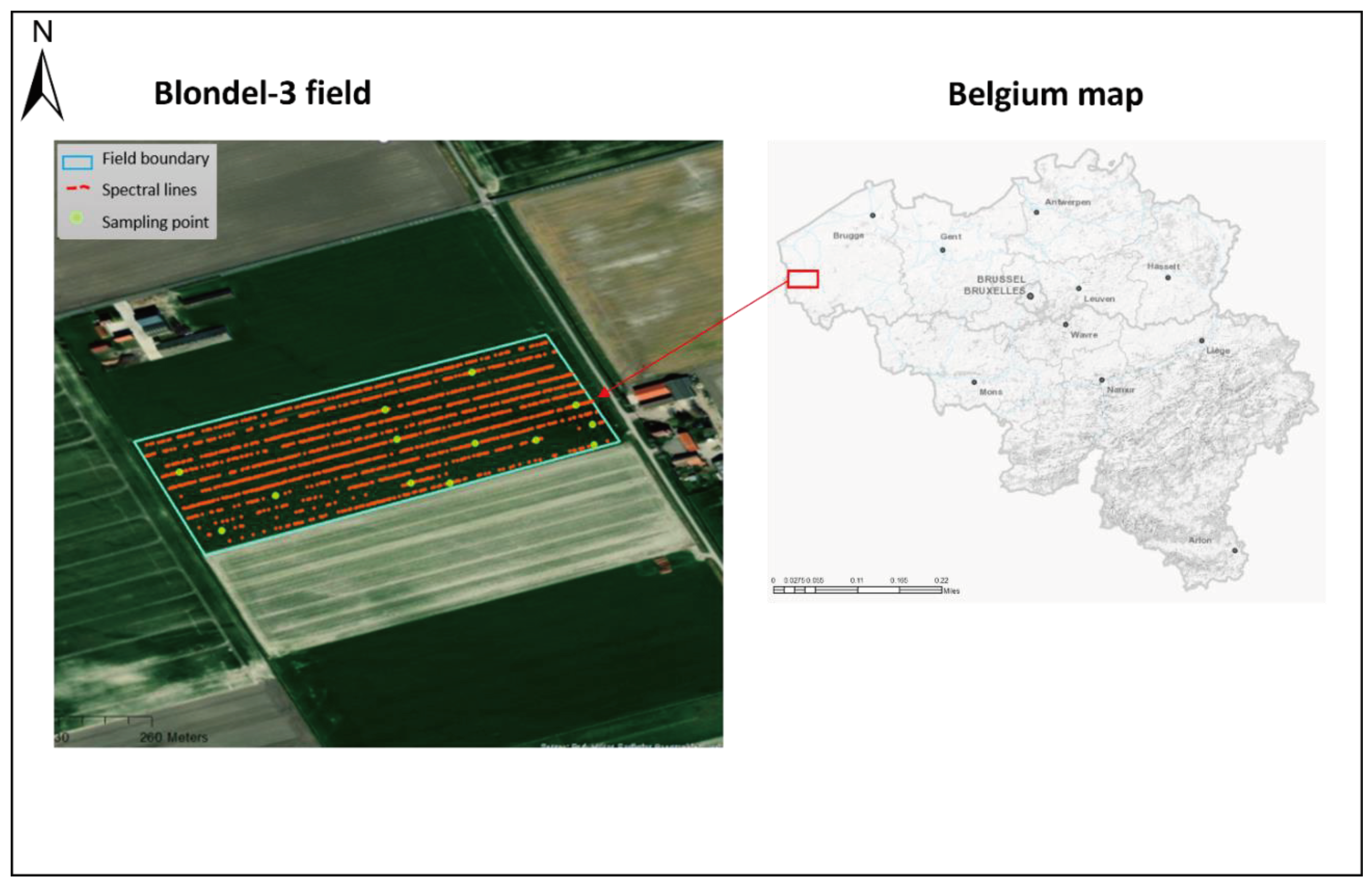
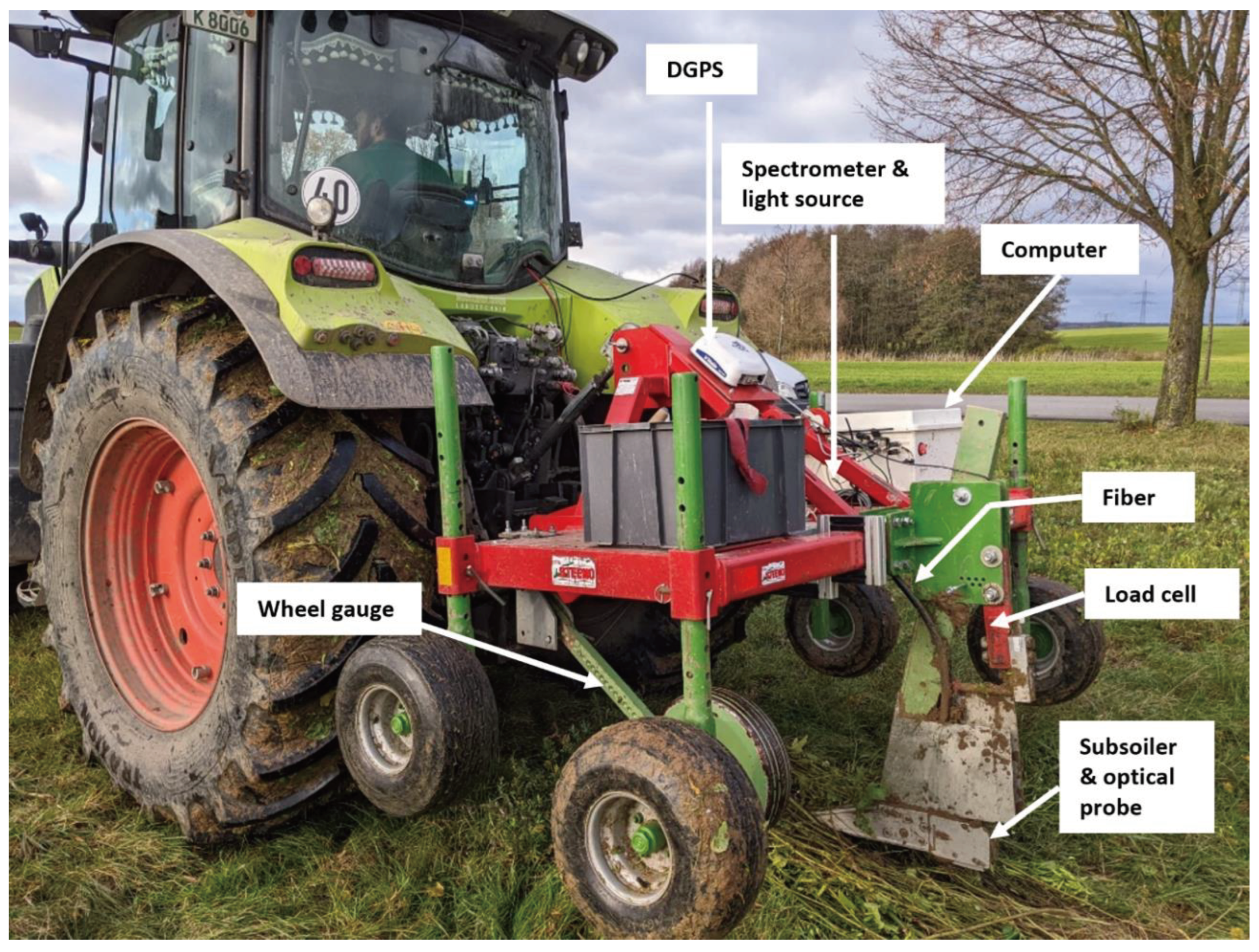
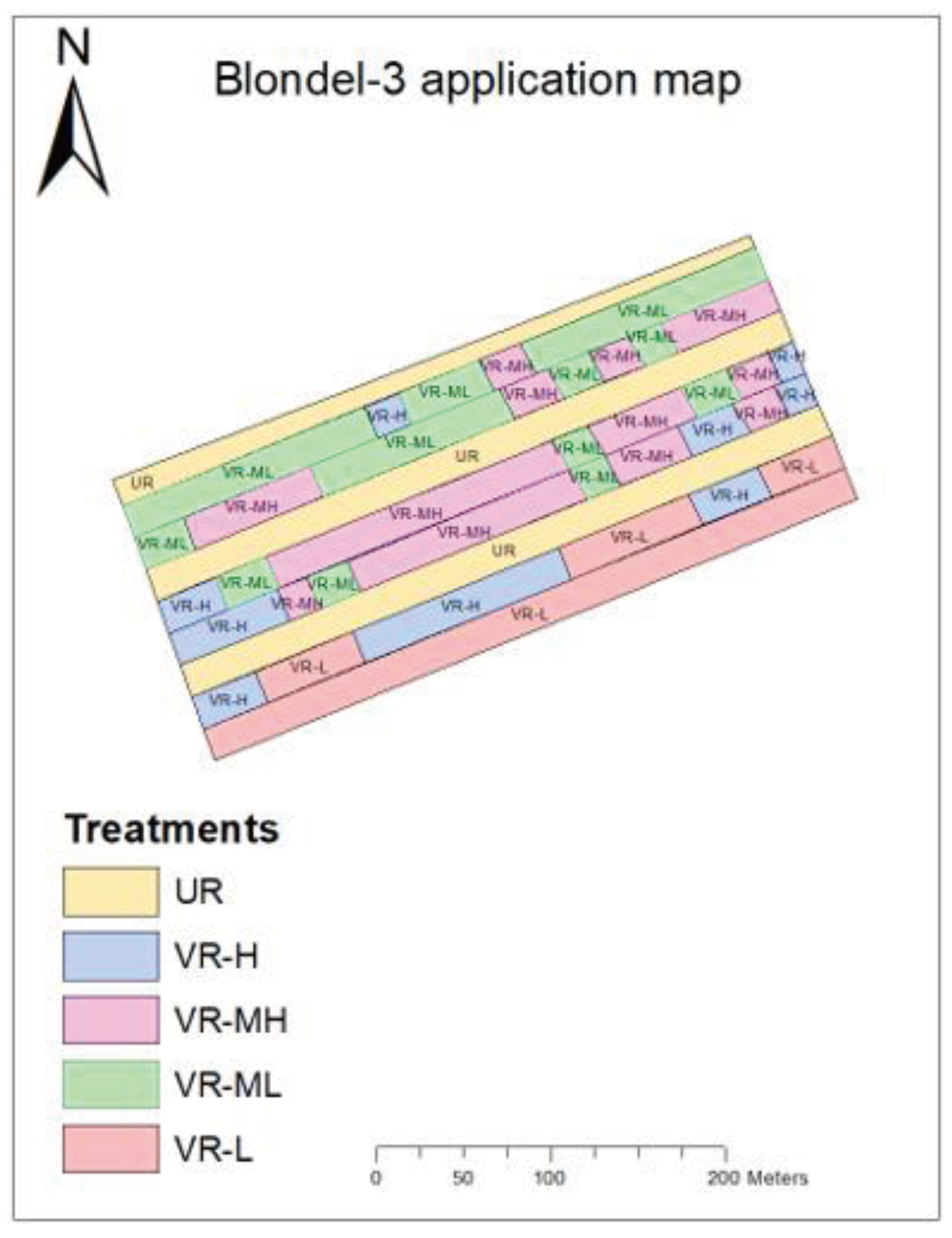
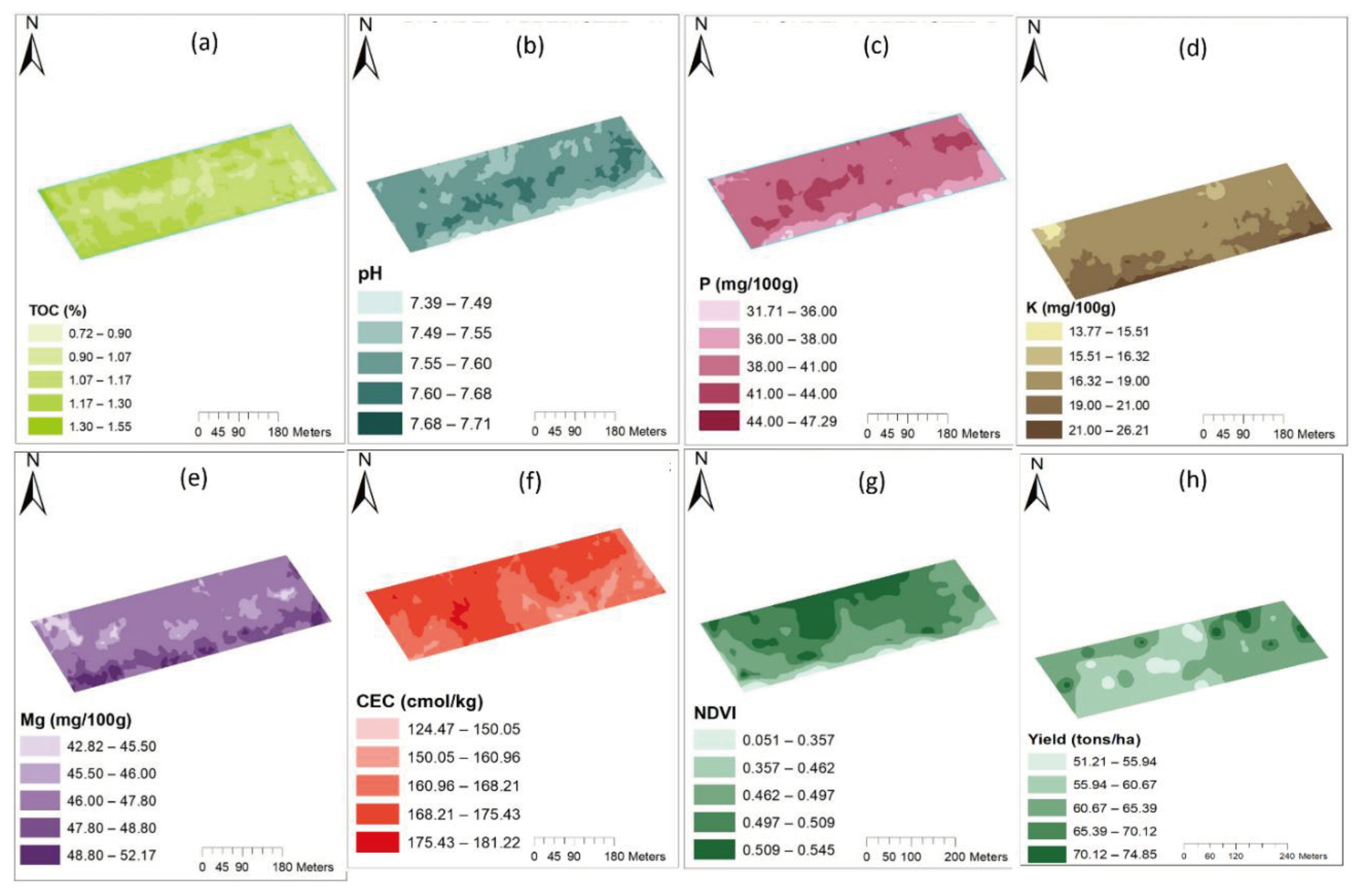
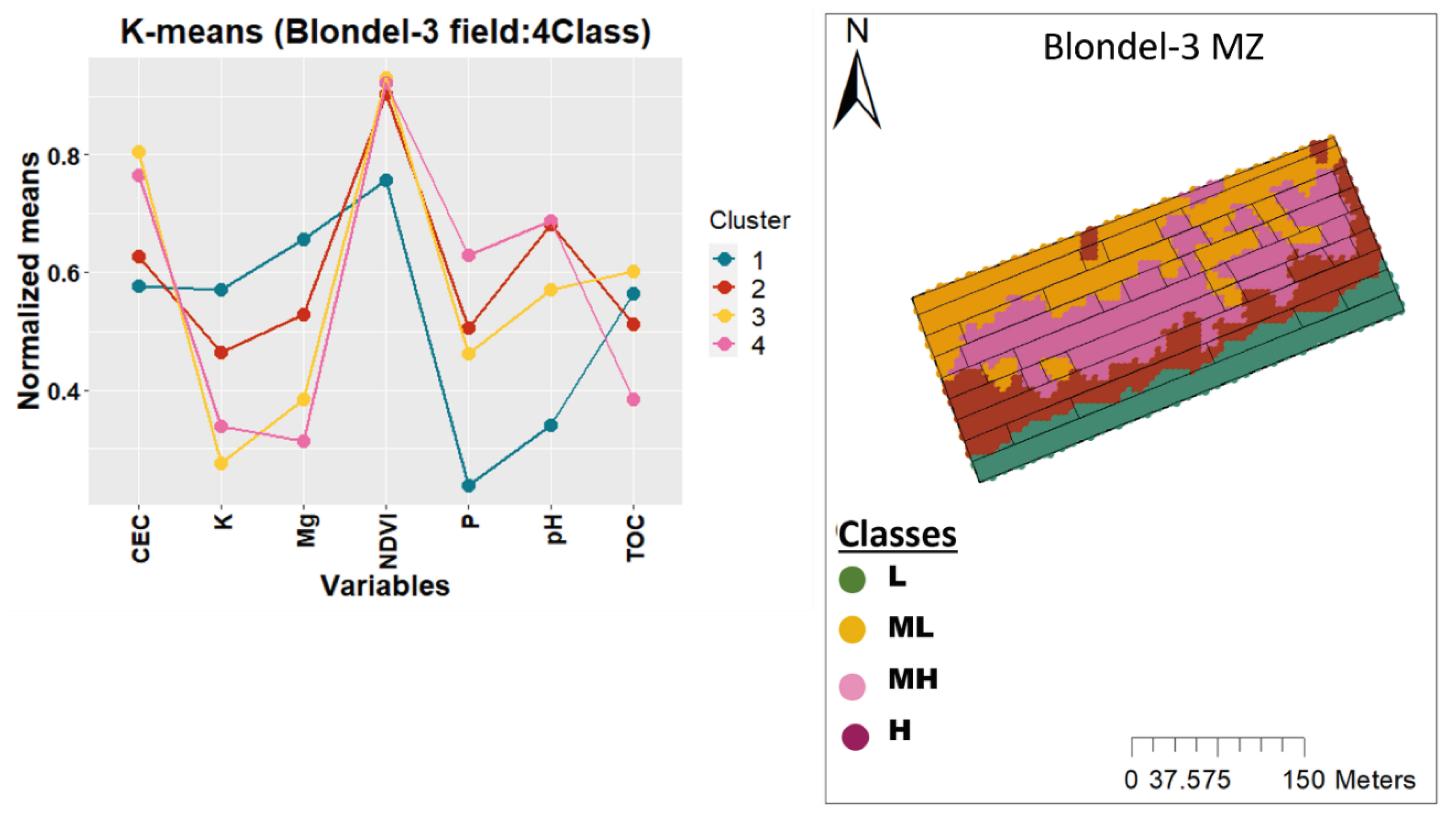
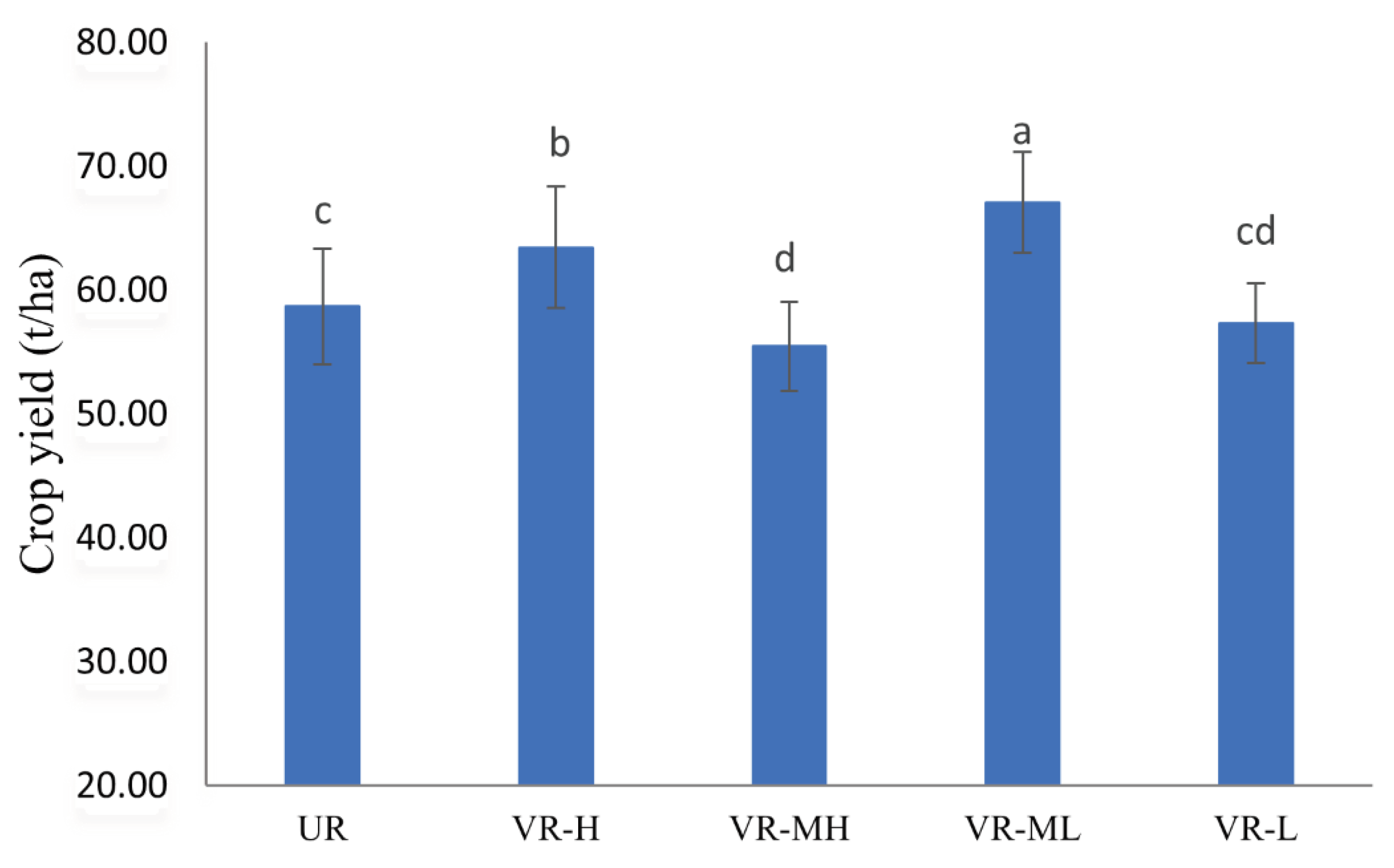
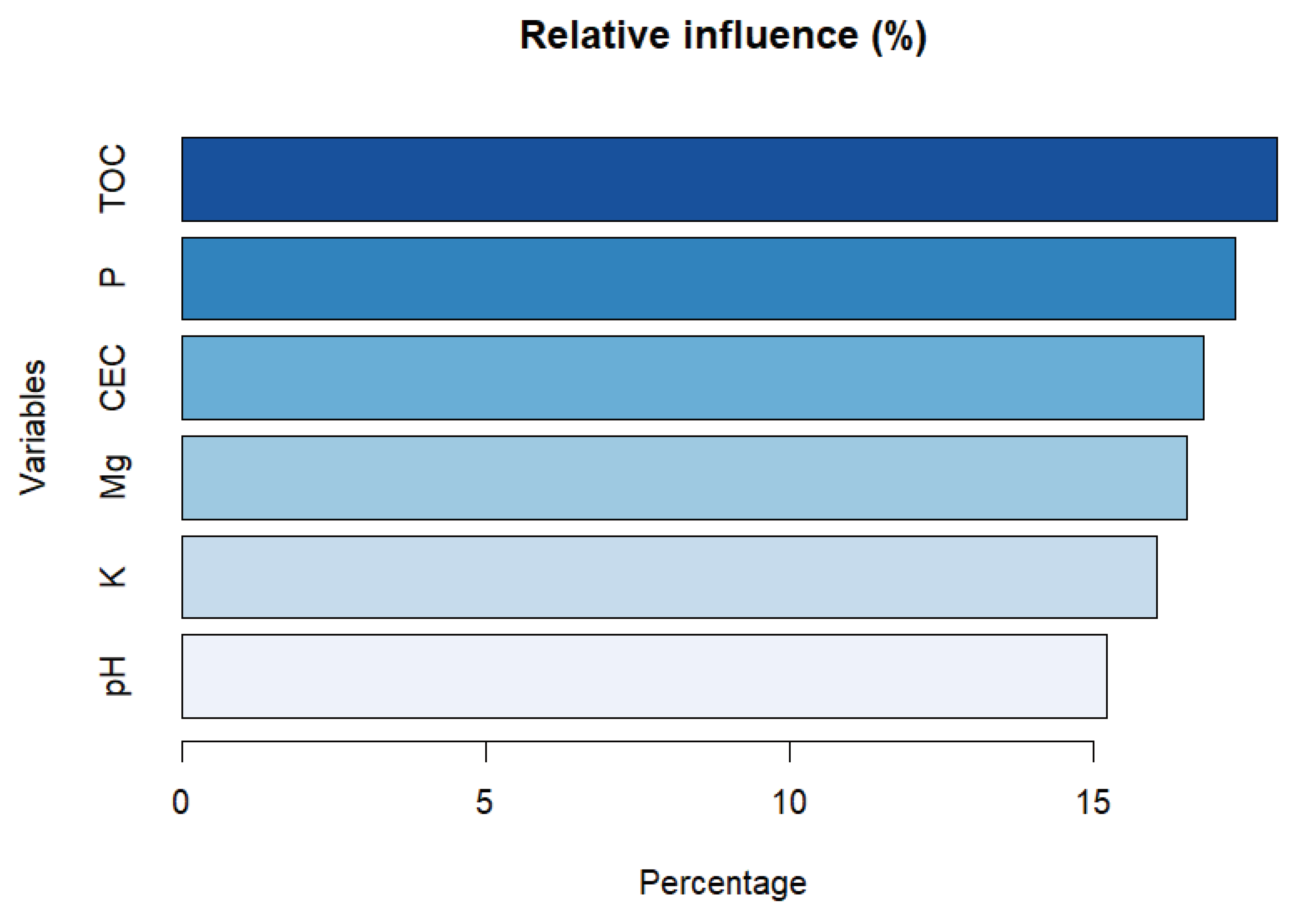
| Samples | Soil properties | Min | Max | Median | Mean | SD | Range | Skewness | Kurtosis |
| Blondel-3 | MC | 4.05 | 6.09 | 4.76 | 4.76 | 0.55 | 2.03 | 0.99 | 3.47 |
| pH | 7.40 | 7.70 | 7.60 | 7.61 | 0.100 | 0.30 | -0.96 | -0.29 | |
| TOC | 0.74 | 1.56 | 0.97 | 1.00 | 0.20 | 0.82 | 1.39 | 1.63 | |
| P | 32.00 | 47.00 | 41.00 | 41.08 | 3.93 | 15 | -0.64 | -0.12 | |
| K | 14.00 | 26.00 | 17.00 | 18.23 | 3.49 | 12.00 | 0.85 | -0.45 | |
| Mg | 43.00 | 52.00 | 47.00 | 47.00 | 2.52 | 9.00 | 0.17 | -0.97 | |
| Ca | 2400.00 | 3500.00 | 3200.00 | 3162.00 | 287.34 | 1100.00 | -1.36 | 1.22 | |
| CEC | 125.40 | 180.20 | 164.80 | 163.00 | 14.33 | 54.78 | -1.31 | 1.10 | |
| Online spiked from spectral library | MC | 4.94 | 24.81 | 14.79 | 14.64 | 6.14 | 19.87 | -0.14 | -1.35 |
| pH | 6.10 | 8.00 | 7.70 | 7.55 | 0.37 | 1.90 | -1.68 | 3.51 | |
| TOC | 0.89 | 2.50 | 1.74 | 1.74 | 0.38 | 1.61 | -0.23 | -0.50 | |
| P | 10.00 | 69.00 | 24.00 | 27.38 | 11.68 | 59.00 | 1.45 | 2.52 | |
| K | 8.00 | 30.00 | 14.00 | 16.72 | 7.34 | 22.00 | 0.49 | -1.23 | |
| Mg | 33.00 | 74.00 | 44.00 | 46.85 | 9.96 | 41.00 | 1.21 | 0.77 | |
| Ca | 1670.00 | 6610.00 | 3330.00 | 3665.50 | 1398.00 | 4940.00 | 0.81 | -0.50 | |
| CEC | 91.59 | 335.92 | 171.91 | 189.33 | 68.80 | 244.32 | 0.84 | -0.46 |
| Order | Moving average | Normalization | SG Derivative | GS Derivative | Smoothing | ||||||
| Soil properties | w | Type | w | p | m | m | w | s | w | p | m |
| MC, pH, P | 3 | 0 to 1 | 7 | 2 | 1 | 1 | 5 | 3 | 5 | 2 | 0 |
| TOC | 3 | 0 to 1 | - | - | - | 1 | 5 | 3 | 5 | 2 | 0 |
| K | 5 | 0 to 1 | 3 | 1 | 0 | 1 | 5 | 3 | 5 | 2 | 0 |
| Mg | 3 | 0 to 1 | 3 | 2 | 1 | 1 | 5 | 3 | 5 | 2 | 0 |
| Ca, CEC | 15 | 0 to 1 | - | - | - | 1 | 7 | 3 | 5 | 2 | 0 |
| Soil properties | Calibration (70%) | Independent validation (30%) | ||||||
| R2 | RMSECV | RPD | RPIQ | R2 | RMSEP | RPD | RPIQ | |
| MC | 0.94 | 1.32 | 4.18 | 8.62 | 0.87 | 1.82 | 2.86 | 2.69 |
| pH | 0.84 | 0.12 | 2.56 | 3.27 | 0.72 | 0.21 | 1.93 | 1.16 |
| TOC | 0.70 | 0.23 | 1.86 | 2.69 | 0.69 | 0.24 | 1.85 | 2.89 |
| P | 0.87 | 3.74 | 2.85 | 3.80 | 0.80 | 6.38 | 2.31 | 2.58 |
| K | 0.70 | 4.68 | 1.85 | 2.24 | 0.71 | 5.06 | 1.92 | 2.81 |
| Mg | 0.96 | 1.81 | 5.36 | 5.51 | 0.73 | 3.57 | 2.00 | 2.58 |
| CEC | 0.91 | 12.15 | 3.53 | 4.21 | 0.64 | 36.85 | 1.73 | 2.79 |
| Treatment | Area( ha) | N-fertilizer Application Rate (N kg/ha) | Fertilizer Cost (€/ha) | Yield (ton/ha) | Revenue (€/ha) | Gross Margin (€/ha) | Relative Gross Margin (€/ha) | Simulated Field Relative Gross Margin (€) | MVN(t/kg) | YRI |
| UR | 2.00 | 39.00 | 39.78 | 58.66 | 11712.91 | 11693.13 | ||||
| VR-H | 0.79 | 19.50 | 63.44 | 1.08 | ||||||
| VR-MH | 1.39 | 29.25 | 55.44 | 0.95 | ||||||
| VR-ML | 1.30 | 48.75 | 67.06 | 1.14 | ||||||
| VR-L | 1.14 | 58.50 | 57.32 | 0.98 | ||||||
| Total VR | 4.63 | 40.24 | 41.08 | 60.55 | 12109.05 | 12067.96 | 374.83 | 2481.37 | 0.68 | 1.03 |
| Treatments | Area( ha) | N-fertilizer application rate (N kg/ha) |
Yield (t/ha) |
NUE (%) | Net N impact ΔN (kg/ha) |
| UR | 2.00 | 39.00 | 58.66 | 58.70 | |
| VR-H | 0.79 | 19.50 | 63.44 | 126.87 | 19.50 |
| VR-MH | 1.39 | 29.25 | 55.44 | 73.92 | 9.75 |
| VR-ML | 1.30 | 48.75 | 67.06 | 53.64 | -9.75 |
| VR-L | 1.14 | 58.50 | 57.32 | 38.21 | -19.5 |
| Total VR | 4.63 | 40.24 | 60.55 | 150.31 | -1.28 |
Disclaimer/Publisher’s Note: The statements, opinions and data contained in all publications are solely those of the individual author(s) and contributor(s) and not of MDPI and/or the editor(s). MDPI and/or the editor(s) disclaim responsibility for any injury to people or property resulting from any ideas, methods, instructions or products referred to in the content. |
© 2024 by the authors. Licensee MDPI, Basel, Switzerland. This article is an open access article distributed under the terms and conditions of the Creative Commons Attribution (CC BY) license (http://creativecommons.org/licenses/by/4.0/).





